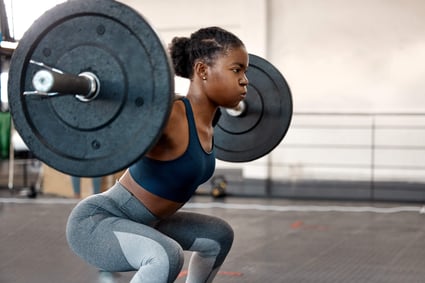In this blog series, I have discussed the four movement patterns for building muscle and broken them down further with exercise examples you can add to your workouts. Then we discussed two upper-body movement pattens, the pull and the push. In this post I discuss the squat pattern, our first lower-body movement pattern.
 The Squat Movement Pattern
The Squat Movement Pattern
The squat movement pattern is a compound movement that works the muscles of the upper legs including the quadriceps and glutes. The squat pattern is an essential movement for your activities of daily living. We use this pattern to sit, to stand, to pick things up off the floor, to walk up the stairs, and for many other activities. It is essential to train this pattern to maintain your lower-body strength as you age to maintain muscle mass and prevent falls.
Training the squat movement pattern to a full range of motion can also improve your flexibility and bone mineral density. Learning how to squat properly, and to a full range of motion, is essential in a well-rounded training program. Within your training plan you can break this movement into bilateral and unilateral patterns. Bilateral means both legs working at the same time, and unilateral means one leg at a time. Utilizing both bilateral and unilateral patterns will ensure you are not creating any imbalances between your legs.
Squatting Variations
Bilateral
- Barbell Back Squat
- Barbell Front Squat
- Goblet Squat
- Leg Press
- Zercher Squat
- Hack Squat Machine
Unilateral
- Split Squat
- Rear Foot Elevated Split Squat
- Front Foot Elevated Split Squat
- Walking Lunge
- Step Back Lunge
- Step-Ups
Quadricep Isolation Movements
- Leg Extension
- Banded Terminal Knee Extension
Get Training Help at NIFS
For more information on how to properly progress and structure a training program, visit our staff at the track desk to schedule a private session. We are more than happy to help at any time, and as part of your membership here at NIFS, you receive complimentary workout programs. Our Health Fitness professionals tailor all programs to your fitness goals.
This blog was written by Evan James, NIFS Exercise Physiologist EP-C, Health Fitness Instructor, and Personal Trainer. To learn more about the NIFS bloggers, click here.

